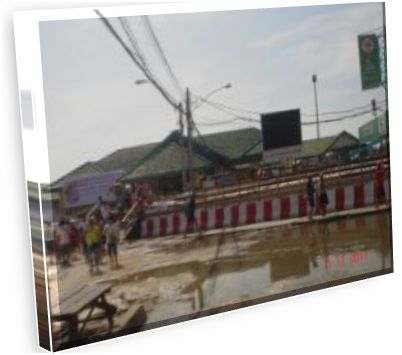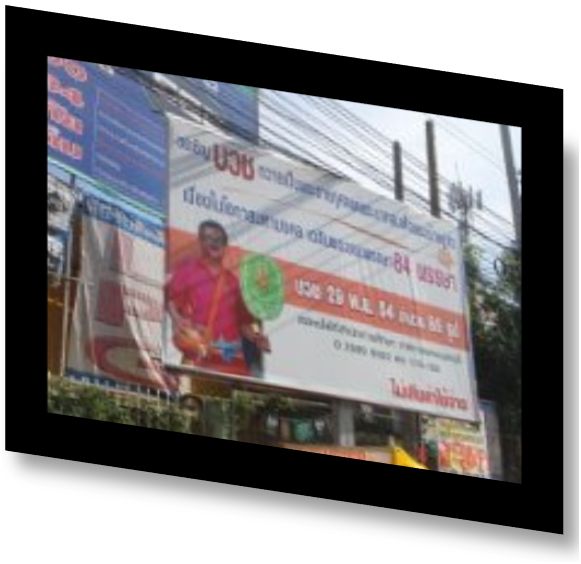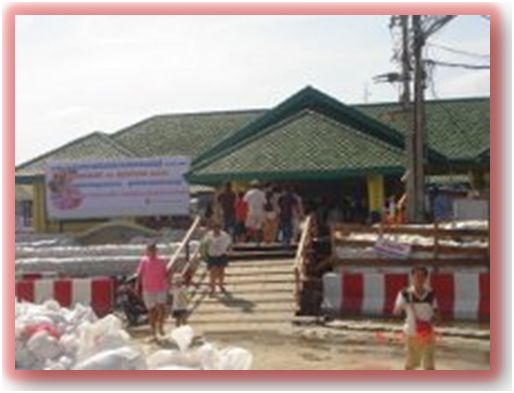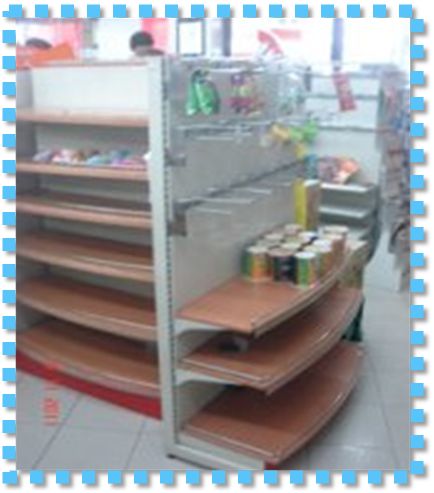A likely setting
Nonthaburi is a riverfront province just northwest of Bangkok proper. It offers contrast and colour unlike the other provinces that are part of the Bangkok metropolitan area, such as Samut Prakarn, Pathum Thani and Thonburi. Its town centre features a dilapidated River Plaza & Major Cineplex mall, where all film showings are in Thai or dubbed into Thai to suit locals, and a bustling open-air fresh market, which is a stone’s throw from the clock tower landmark next to Nonthaburi pier. Here at Nonthaburi pier station is the end of the line for Chao Phraya Riverboat travel into and northwards out of Bangkok, an underused mode of commuting for northern suburbanites. Excursions to tourist spots like Koh Kred also originate from Nonthaburi pier. Field Marshal Phibun Songkram’s old abode is located just a few kilometres down the river, around a bend on Pibulsongkram Road, which curves in parallel to the Chao Phraya. It was here that the strongman raised hens and grew vegetables during his hiatus between two prime ministerships in the mid-1940s.
Among the enmeshments of the old and the new in Nonthaburi is the juxtaposition of well-placed pedicabs that are vastly outnumbered by the ubiquitous motorcycle taxis. I once queried pedicab drivers why their vehicles hadn’t become mechanised to compete. Their small bench seat, along with its slow but stable speed, was the answer. Pedicab seats are sufficient to accommodate a Thai adult and a child and big enough to store groceries and belongings which motorcycle taxis cannot handle. The ranks of pedicabs have thinned markedly over the years but they still ply the streets in the town centre. They require only labour while the motorcycle taxis must run on petrol and come with a five-figure start-up fee for the acquisition of those coloured, designated vests, the proceeds of which are funnelled into the black hole of local corruption. The Nonthaburi pedicabs impart a sense of provincial charm so close to Bangkok.
Until two decades ago, Nonthaburi was mostly famous for its fruit orchards, especially its signature and sumptuous Durian varieties, the most famous being the kan yao (long stem). Extensive fruit plantations and dense forests have since been cleared to make way for housing communities, convenience stores, restaurants, and shops of all types. While commerce and residential housing grew, government offices also flocked to Nonthaburi. Its Chaengwattana Road has become a hub of ministries, and the ministry of public health is only a few traffic lights from the Nonthaburi pier. It seems the town-changing developments were the openings of the Chao Phraya-crossing Rama VII and Rama V bridges in 1992 and 1999. The past decade has merely been the intensification of Bangkok’s northwestern suburbanisation.
The besieged pier
Local government rocks
As the flood crisis intensified in early October, Nonthaburi living induced plenty of phone calls from friends and relatives. The Chao Phraya, after all, cuts through the province. The set question was whether ‘your house been flooded yet?’ It seemed inevitable. By mid-October, the swollen river was ominous, its surface almost matching the stacked sandbags all along Pibulsongkram Road. Floodwalls downstream on Samsen Roadhad already been breached. Bad news from Bang Bua Tong, Bang Kruai and Bang Yai districts of Nonthaburi suggested it was only a matter of time. As a sign of the times, Natpob (meeting place), a normally brisk local eatery on Pibulsongkram and one of the most authentically Thai restaurants in greater Bangkok, was nearly deserted.
Somnuek Thanadechakul is the mayor of Nonthaburi’s Muang District (Amphur Muang). His appearance in self-promoting billboards around the town centre is ubiquitous and typical of typically unsavoury politicians in Thailand. His name is emblazoned on local government equipment, like benches and chairs used in local festivities. The marble benches at the local police station bear his name. One would imagine a local politician like him to be on the take, seasoned in kickbacks and unsuited for flood management. But he surprised many.
The eastern side of the Chao Phraya in Nonthaburi’s Muang district was kept dry by a million sandbags, which were piled four to eight bags high, depending on flood threats. At the pier, the sandbags were organised into three to six layers deep almost like the bunkers of an impending battle. Controlled flooding was allowed. Parts of the embankment took in water up to a point. This was not pumped back into the river. But designated flood-fighting areas inside catchments within the rings of sandbags were on a constant pump operation. At its worst, in the last week of October and early November, when Pibulsongkram Road was eerily quiet and residents braced for a deluge, the river brimmed ominously.
A few choke points like the local technical college down on Pibulsongkram were breached by floodwaters. But Somnuek, his staff and local volunteers, assisted by a local MP named Nithat Srinont, commanded the scene from a bunker near the pier, ordering officials and local folks to plug this and that leak along the floodwalls. They went up and down the stretch of Pibulsongkram Road for days and nights to ensure the sandbags withstood the river’s rise. The river current also moved at a remarkable southwards pace, thereby exacerbating pressure on the floodwalls. It was an hourly crisis-management which the central government was ill-equipped to handle.
Ultimately, except a handful of riverfront sois, Pibulsongkram Road was dry. Somnuek, after the first week of November, widely called Pa (rising tone) as a paternal term of endearment by locals, got the job done. He even got to speak on TV about what local government can do, with newspaper features to boot. Local government can work. Maybe Somnuek is on the take, maybe not. Locals seemed to care less for whatever unscrupulous deeds he might have schemed but they uniformly approved his performance. To them, it mattered most that the mayor delivered.
The unlikely hero of Nonthaburi ….
…. dispensing patronage, here at the main police station

The complexities of wet and dry
Who gets wet and who stays dry? This was the overarching theme throughout the flood crisis. For the authorities in the national government and theBangkok metropolitan administration (BMA), it was a contentious dilemma. As the excessive water meandered its way down the Chao Phraya river basin in September, from Nakorn Sawan and Chainat to Lopburi and Angthong, and eventuallyAyutthaya, floodwaters were everywhere. The inundated Honda factory, with brand new Hondas awash under water, became emblematic of the plight of industrial estates in Ayutthaya province.
As upstream provinces became submerged, both the Yingluck government and the BMA insisted thatBangkok’s floodwalls would hold and the capital had to be saved at all cost as it was the heart and soul of the economy. This blatant Bangkok-centred inequality was repeated in October when the waters reached Bangkok’s northern outskirts in Pathum Thani and Nonthaburi, especially Bang Bua Thong district in the latter. The lopsided duality operated at both levels, upstream versus downstream and Bangkok’s outskirts vis-├а-vis Bangkok’s central business district. It was a reverse geography of the red-shirt demonstrations and occupation of Ratchaprasong intersection in April-May 2010. Downtown areas that were adversely affected by the Ratchaprasong turmoil have been dry during the floods, whereas unaffected areas in 2010 have mostly been wet. Something is fundamentally unfair about this manifestation of wet and dry. Perhaps an ankle- or knee-high submersion of central Bangkok would allow faster release of floodwaters into theGulf of Thailand and yield a semblance of fairness?
My prejudicial bias was tested in Nonthaburi. As measurements, based on an imagined and collectively averaged Thai height, inundation is pinpointed as high as ankle, knee, waist, and chest, beyond which resistance is futile. The problem with these floods is the difficulty of controlling the slippery upwards slope from ankle to knee, from knee to waist, and so on. Allowing a shallow flooding of Bangkok may not be so simple. This same logic applied to Nonthaburi. At the pier area, residents bickered and fought. The western side in Tambon Bang Sri Muang (a sub-district) suffered a considerable submersion between knee and chest but the eastern side in Tambon Suan Yai on the pier side was dry. The western residents wanted to dismantle the sandbags on the eastern side. With the Chao Phraya water levels in October and early November, this would have meant flooding on both sides. The western side would not have been better off, except to have the satisfaction of seeing residents on the eastern side suffer in the same way.
The mayor and local MP intervened in the feud with a compelling logic. They told the Bang Sri Muang residents that the Nonthaburi market and convenience stores are on the eastern side. If these were dry, then the wet residents from the west bank can sustain their livelihoods. Alas, they would get something in return for being wet! The authorities lifted the ferry fees for crossing the river. Residents of the west bank agreed. Ferry crossings were soon full of flooded residents visiting the market, banks and stores on the east side. These residents found compensation in the trade-off. The conflicts between upstream and downstream provinces and Bangkok proper andBangkok suburbs would have benefited from a similar scheme. If suffering people who knew they cannot escape the floods got something in return, they might have gone along more peacefully. But when central Bangkokwas to be saved at all cost without recompense for victims in adjoining and adjacent areas, the outcome was anger and resentment.
Ferry passengers during the flood
My house for a 7-Up!
One of my bad habits is the consumption of soft drinks. I spent early November on a quest for a 7-Up in Nonthaburi, traversing the town from one store to the next, starting with 7-Elevens and Minimarts before moving to the hypermarkets. None was to be found. Sprite was around but it is inferior. Besides, it won’t do for my potent, well-kept margarita blend. It’s interesting what was available during the floods and what was not. Easy and cheap eats like instant noodles were wiped out but bathroom amenities were around. Store minders told me it’s less due to hoarding and more to a lack of resupplies. Logistics were shot. Factories were closed. Workers tended to their homes and loved ones. Some still operated but few and far in between in the outskirts ofBangkok. Not even a house could be traded for a 7-Up at the height of the floods.
No mama!
The car
Cars, of course, are not just vehicles meant for transport. They can be an expression of the self, the proverbial ‘face’ and status symbol, especially in developing countries. During the floods, there was an unprecedented spectacle of cars parked illegally onBangkok’s expressway and flyovers. Pavements with any elevation all seemed taken by parked cars. Deputy Prime Minister Chalerm Yoobamrung even encouraged this flagrant violation of the law. He told the police to go easy with vehicle owners. On the expressway, I saw wheel clamps slapped on a few cars, but it turned out these clamps were not by police but by the owners to prevent theft. A wide assortment of taxi companies, fast-food proprietors, and private owners of BMWs Series 7 all parked their cars on the expressway. This gave rise to a brisk motorcycle taxi business, which was needed to bring drivers up and down the expressway. It was a scene of breath-taking chaos. Thankfully, we didn’t need the expressway for serious transport as a re-supply or emergency relief route because it was so clogged. What the government should have done was to designate safe and secure parking areas in the dry outskirts – perhaps to the southeast of Bangkok towards Chonburi – for vehicles under the threat of flood.
The car is also a taxi. Taxi drivers had a different experience. Almost all taxis are now run on natural gas, either LPG or NGV. The latter faced scarcity because it is three to four baht cheaper than LPG. Arguably the most respectable taxi driver in these parts is one 50-something Naa Nooporn (uncle Nooporn, his cute-sounding nom-de-soi), whom his taxi colleagues call Pi Thep. Naa Nooporn is a would-be member of the ideal society, hard-working and morally upright. He lives in a kind of a shack that passes as a townhouse. Its first floor is a rice-and-curry business tended by his wife, with his two children of secondary school age assisting. He dons a well-worn blue shirt with his name sewn on it each day he drives. His name and face actually match the taxi photo ID on the dashboard, uncommon in Bangkok’s taxis. By early October, Naa Nooporn was out of work. The taxi business was no longer a viable living. The queue time for NGV gas was upwards to three hours. Some NGV logistics were cut off. Some gas stations closed shop. Passenger proceeds hardly paid for the daily rent to the taxi owner (tao kae). For two months, Naa Nooporn joined his wife and expanded into a la carte, from curried rice and sticky rice to somtam and grilled catfish, and so on. I knew by late November that normality was in reach when NGV queues shortened. But Naa Nooporn has lost his taxi slot until January. Only when I see him behind the wheel again will full normality resume.
Volunteerism and the salim phenomenon
For a time, an outpouring of sympathy and charity from Bangkok to the suburbs and provinces from well-heeled central Bangkokians dominated the news. This public service was substantially genuine, especially when it was not in the news. Selfless and organised charity kitchens for relief opened up everywhere. Faceless volunteers manned the stoves and frying pans, packing tables and distribution chains all the way to delivery trucks. But in some places, as gleaned from newspapers, TV, and anecdotes here and there, a tinge of top-down patronising and subconscious contempt underpinned some of the charity work.
Until the floods hit the capital, the Bangkok-centred charity became fashionable and chic – indeed, ‘in trend’ in the parlance of Sukhumvit Road. They may not have treated their servants at home all that well but some of central Bangkok’s good Samaritans wanted to help flood victims elsewhere and craved to be newsworthy for it. Their doing was to be known and seen. In colour codes, they somehow bore a striking resemblance to the multi-coloured shirts (i.e. mainly former yellow shirts who distanced themselves from the 2008 illegalities, especially the airport occupation) who occasionally took to the streets against corruption and changes and challenges to the status quo. The society magazines and gossip pages will attest to these dynamics. Many who normally hung out in CBD oases like Paragon or Central World malls congregated at relief centres to donate and/or help with the packaging and handouts before they headed out to cushy condos in Hua Hin or Rayong or hilly homes in Khao Yai. These victims elsewhere were to be rescued by central Bangkokians, not to stand up for themselves and help themselves. This world-view that the rest of Thailand is to be helped and saved is part and parcel of the colour divisions. The baan nok (upcountry) provinces are meant for Bangkokians’ charity of their choice and convenience. Heaven forbid that these lower-income provinces and outlying areas should see self-empowerment from state policies.
The multi-coloured salim, analogous to a dessert which appears as soft cellophane noodles soaked in sweetened coconut milk and smothered with shaved ice, is the latest hip term that encapsulates the multi-coloured phenomenon. It is variously characterised by superficiality, pretension, ostentation, contradiction, and hypocrisy. It manifests in doing the right thing to be known and seen for doing the right thing, such as good doers in places farther away who don’t take good care of their domestic help or don’t know the poor rungs of society who dwell in their own soi or on nearby streets. The salim types are born into the good life, or have made it in society, or are making it, or could soon be making it. Drawn considerably from the ascending middle classes, they have upward social and professional mobility, not the hapless chao baan (regular folks) who along with their offspring are always going to be chao baan.
Salim types harbour a natural disdain for the red shirts. They see Thaksin as the root of all that has gone wrong with Thailand in view of his corruption, human rights violations, and abuses of power. Salim types delude themselves into seeing Thailand as white and black when it is grey all over. Stuck in a holier-than-thou, superiority complex, they see themselves on the right side of Thailand’s divide. They necessarily conflate Thaksin’s corruption with his resilient electoral appeal to upcountry folks because they cannot accept the alternative explanation that the majority of voters want to be counted and respected. This is why salim types are not fond of the one-person, one-vote system.
Thaksin is most definitely a corrupt and flawed leader of the highest order but something about his rule has changed Thailand. For salim types, Thaksin has vastly intoxicated and misled the electorate; voters must not be sufficiently informed if they opt for his party. If Thaksin were cremated tomorrow, salim types would have to recover his ashes and reconstitute his body, lest their Manichean worldview unravel. That voters keep going back to him, his sister, cronies and political parties can only be attributed to his corruption, salim types would rationalise.
To be sure, salim types are not bad people. Most are actually good, giving and empathetic. They are just less special and less righteous than they think, living in a pervasively grey land with corruption, conflicts of interests, vested interests, and all kinds of interests that exclude none. The mention of salim types is meant neither to ridicule nor to alienate them. Indeed, salim types are indispensable building blocks inThailand’s murky path towards peace and stability. Only when they can be persuaded to recognise the negotiable and workable greyness in local manifestations, manoeuvres and machinations will a chance to bridge the divide arise.
What to read
There was a palpable paucity of punditry during the floods. The leading blogs went quiet. Bangkok Pundit’s scientific approach made a few rounds but the likes of Political Prisoners of Thailand and New Mandala appeared unengaged. There were of course water management experts all over the news but they were not the politics and economics types. Theirs was a niche expertise. Yours truly suffered a similar lull, having wasted three weeks following the news, answering and producing emails and telephone calls all about the impending floods. The last time I thought I knew anything about water management was in the early 1990s when I quizzed some farmers in Singburi about why they were digging 20-25 metres underground for water. It was a period of drought, not flood. My cluelessness rang home when I looked at maps and still couldn’t grasp why Klong (canal) Bang Kuntien, which is a district in Thonburi, ran through Nonthaburi near my house. Give us pundits a coup, bogus constitution, colour divisions, and street clashes and we can’t hold our thoughts and keyboards still. But a flood forced us to sit back and watch, and watch. Was the flood coming to the house? Were relatives, colleagues, and all the friends and acquaintances whom I hadn’t seen in months and years going to be flooded? Was anyone I know going to die from this?
Flood times did not feel conducive for serious, in-depth work, only odds and ends. I read an academic paper there, the Economist here, writing fragments and notes but not much was produced substantively. I wrote just a piece and waited to read from others for therapy and commiseration. As expected, Nidhi Eoseewong, Thailand’s greatest living public intellectual, came in with yet another subtly thumping weekly column in Matichon Sudsapda, powerful in insight and plain in exposition, as is his style. He bemoaned Thailand’s industrial bias – i.e. industrialist groups proclaiming their losses and needs for compensation – and pointed out the Thai media’s utter failure to provide an overall understanding. He found from a farang newspaper that Bangkok’s flooding covered about 30 per cent of the total land area. I got another fix, a somewhat philosophical take, from Ajarn Mingsarn Santikarn Khosa-ad, who directed my water management team study two decades ago. She made a case for living with floods, an aquatic and amphibious life and livelihood, not soothing for flood victims but ultimately sensible and imperative forBangkok and provinces in the central plains.
In my small library lurked a book named King of the Waters. This is one of those books I purchased and read anywhere from half a page to half of its entirety, putting off the rest for fanciful retirement time. It proved that collecting interesting books is worthwhile. King of the Waters is authored by Han ten Brummelhuis, whom a senior Thai ajarn teased as a dancing goose (han ten) over a dinner back in 1999. I have not seen Dr Brummelhuis since. Few books could have provided more therapy, insight and instruction than this incisive biography of a self-righteous Dutchman – Homan van der Heide, the subject of the book’s title – who happened to be a water expert unrivalled inSiam just over a century ago. It is as difficult to blame Yingluck without blaming Abhisit as it is to blame both of their governments without blaming their predecessors. From this book, the buck can be traced back to the 1900s. Van der Heide had a good plan for Siam’s floods but a poor political game in the Siamese court. Ultimately, his irrigation and flood-management master plan was stymied not on merits but by the nuances of court machinations, befell by an insecure and incapable overlord. He was dislodged in 1909. Flood management has been patchy and piecemeal since.
After the floods
Post-flood is no different than pre-flood, riven by the same polarisation and confrontation. The only difference is that the water is mostly gone, evaporated and released into the sea. A blue-ribbon flood management committee has been organised but its results are likely to be marginal and stop-gap. Even if another Van der Heide were to appear, it is too late for a comprehensive plan in one fell swoop. Too much is at stake. Moving the capital to higher ground is a moot point. Land costs are too high for a master floodway. Higher ground will be sought for homes but industries will remain vulnerable. Floods will come again. Perhaps the magnitude of what we have just seen might not transpire again over the rest of my lifetime. But my nine-year-old is likely to see another one in her time. At issue will beThailand’s remarkable absorptive capacity. I hope it will remain ample and elastic when the next big flood arrives.
[Text by Thitinan Pongsudhirak, Graphics by Petra Pongsudhirak]
 Facebook
Facebook  Twitter
Twitter  Soundcloud
Soundcloud  Youtube
Youtube  Rss
Rss 


